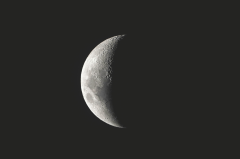The Moon. Our moon. Your moon. Everyone feels as though they have a personal relationship with the moon. At one time or another, you will have said to yourself or a friend, “Isn’t the moon gorgeous tonight?” We imbue the moon with personal qualities easily and find meaning through it eagerly. Even in an age of scientific theology, we casually believe that the moon has effects on us and life on the planet. The moon is a powerful celestial focus in the human consciousness and taking time to consider the nature of the moon, and our evolving relationship with it, reveals as much about us, and you, as we learn about our lunar neighbour itself.
Baby Moon
Life on earth would look very different if we did not have the moon, which begs the question, where did the moon come from? The answer that Mother Earth gave birth to the moon about 4.46 billion years ago.
It was a traumatic birth by all accounts. The scientific consensus is that while the earth was still forming, it was struck by an object that was approximately the size of Mars. A huge chunk of the earth was broken away by this impact and the energy of the impact melted the rock that was to become the moon’s surface. As the molten rock gradually cooled and solidified, it became the silvery mantle that you can see when you look up at the moon at night. Of course, the lunar surface has been modified across the billennia by lava flows, asteroid impacts and the erosive effects of space. Yet you can still look up and see something that broke off from our planet more than four billion years ago. If earth had not birthed The moon, things would be very different and, at some level, humans have always known that transformative fact.
Holy Moon
Most cultures have goddesses or gods linked to the moon. This is not surprising when you consider how large the orb looms in our night sky, and how its position and changing phase are linked to changes on this planet. Perhaps because of the association between lunar months and the menstrual cycle, many of these moon deities are goddesses, but there are also some male moon gods as well.
Chang’e is a female Chinese moon deity also known as the “moon Fairy” in some Chinese mythologies. Artemis was another female goddess, this time from classical Greek mythology. Ix Chel was the Mayan moon goddess who appeared in two forms, that of a sensual young woman or a powerful older woman (not that those qualities cannot intermingle, of course).
Su-en, the Mesopotamian moon god, was the husband of the reed goddess and father of the sun god. In Japanese Shinto cosmology, Tsuki-Yomi was the moon god and brother of the sun goddess, Amaterasu.
Although the moon may not entirely retain the mythic place it once had in our consciousness, it certainly has not loosened its grip on our collective psyche. And you can see that just by looking at our language.
Wordy Moon
The word “moon” is a multifaceted chameleon in our vocabulary. We use it in different forms and attach a range of meanings to it.
Of course, “moon” functions as a noun, but it also does some work as a verb. “mooning” can be one of two things. It can refer to absent-mindedness or distraction, as in phrases such as “moon around” or “moon over”. Alternately, it can refer to exposing your buttocks because buttocks can be pale and round.
Beyond functioning as both a noun and verb, there are many idioms attached to the word “moon”.
- Asking for the moon” is making unreasonable requests.
- “Cry for the moon” is to wish for something unattainable.
- “Reach for the moon” is to set high goals.
- “Over the moon” is to be pleased.
- “Love you to the moon and back” refers to a boundless love.
The moon clearly shapes our thoughts in profound ways, but equally it shapes life itself.
Gravity Moon
One of the most obvious ways in which the moon affects life on earth is by pulling the oceans and creating tides. The moon’s gravitational pull causes the oceans to bulge out on both the side closest to the moon and the side farthest from it. As the ear





